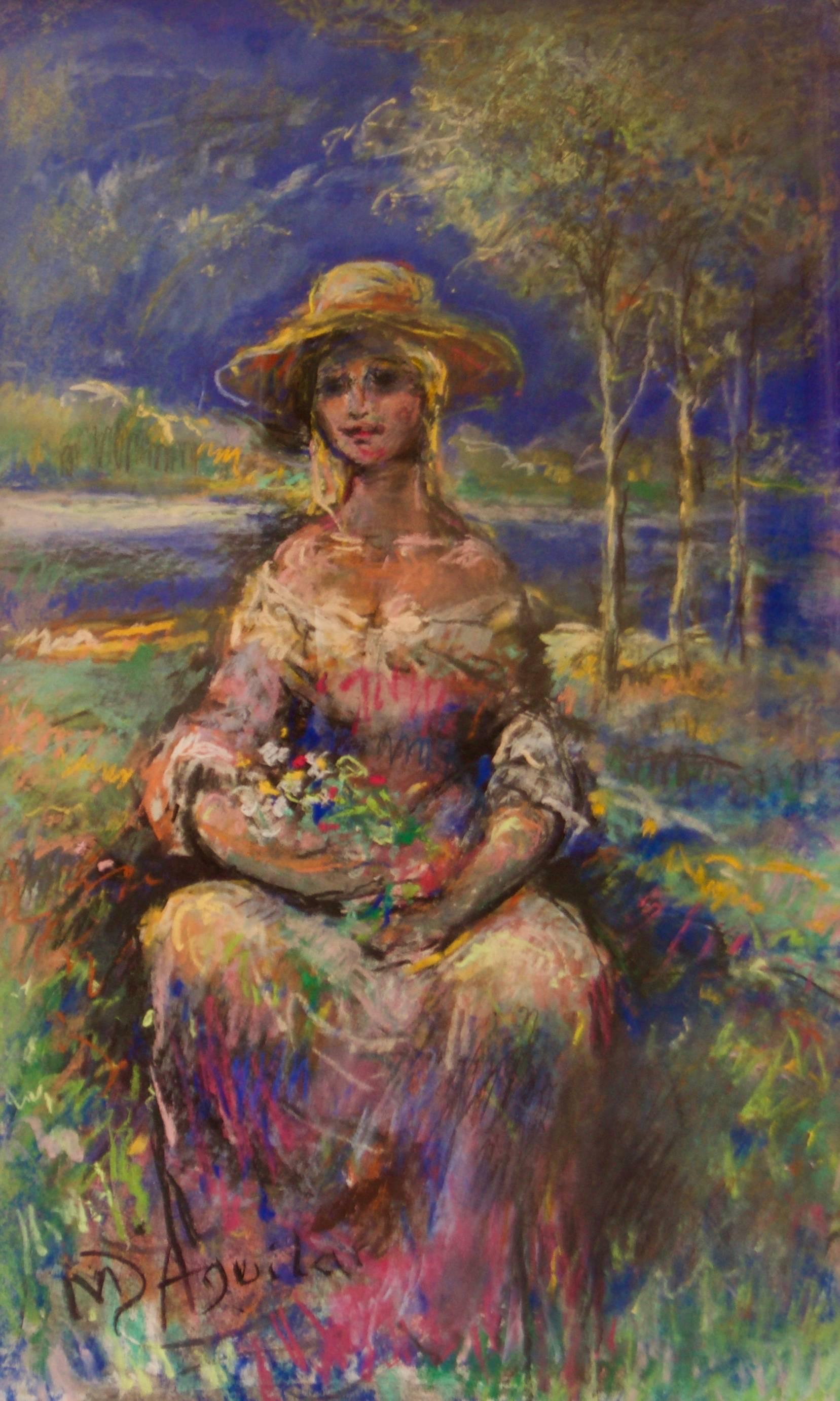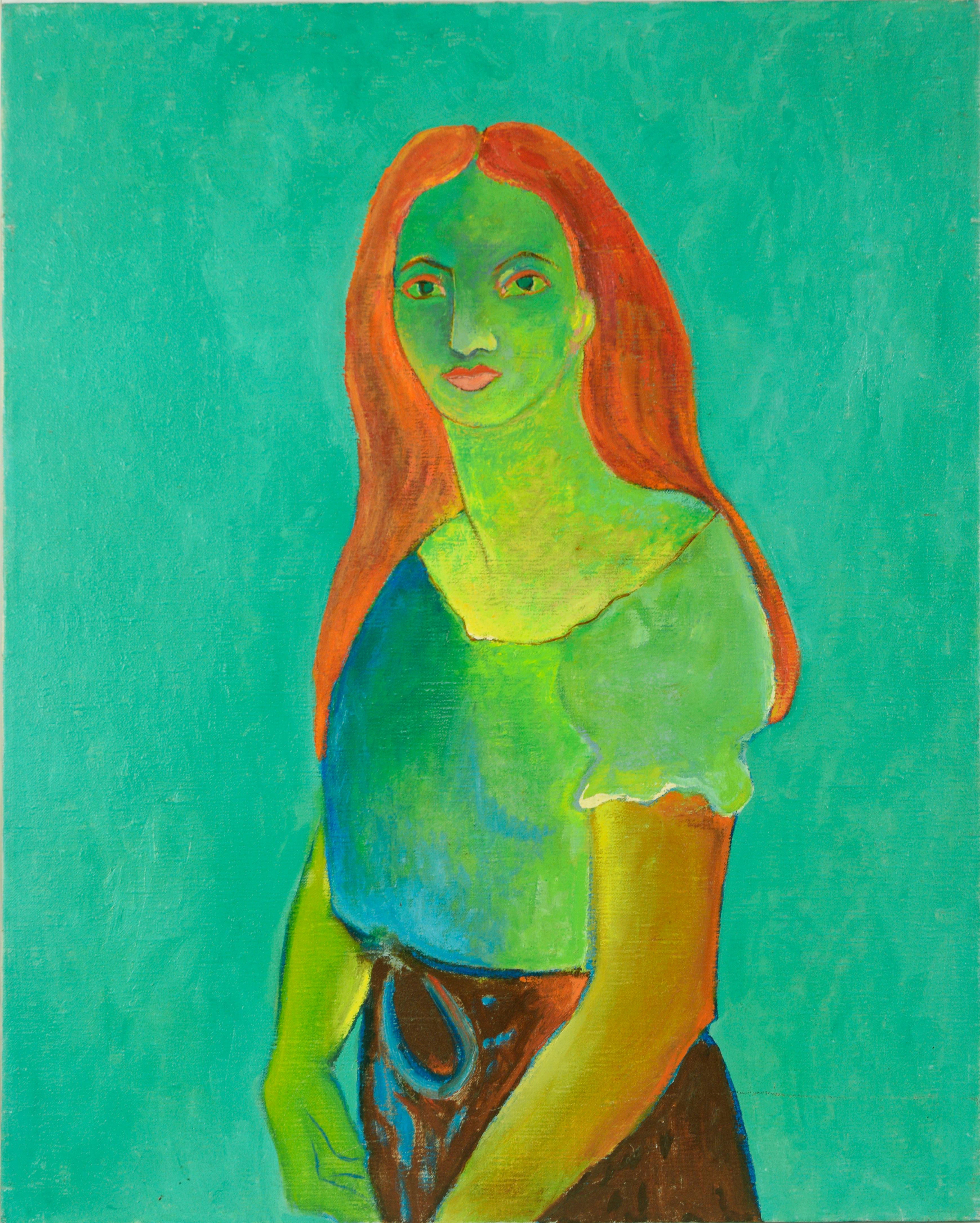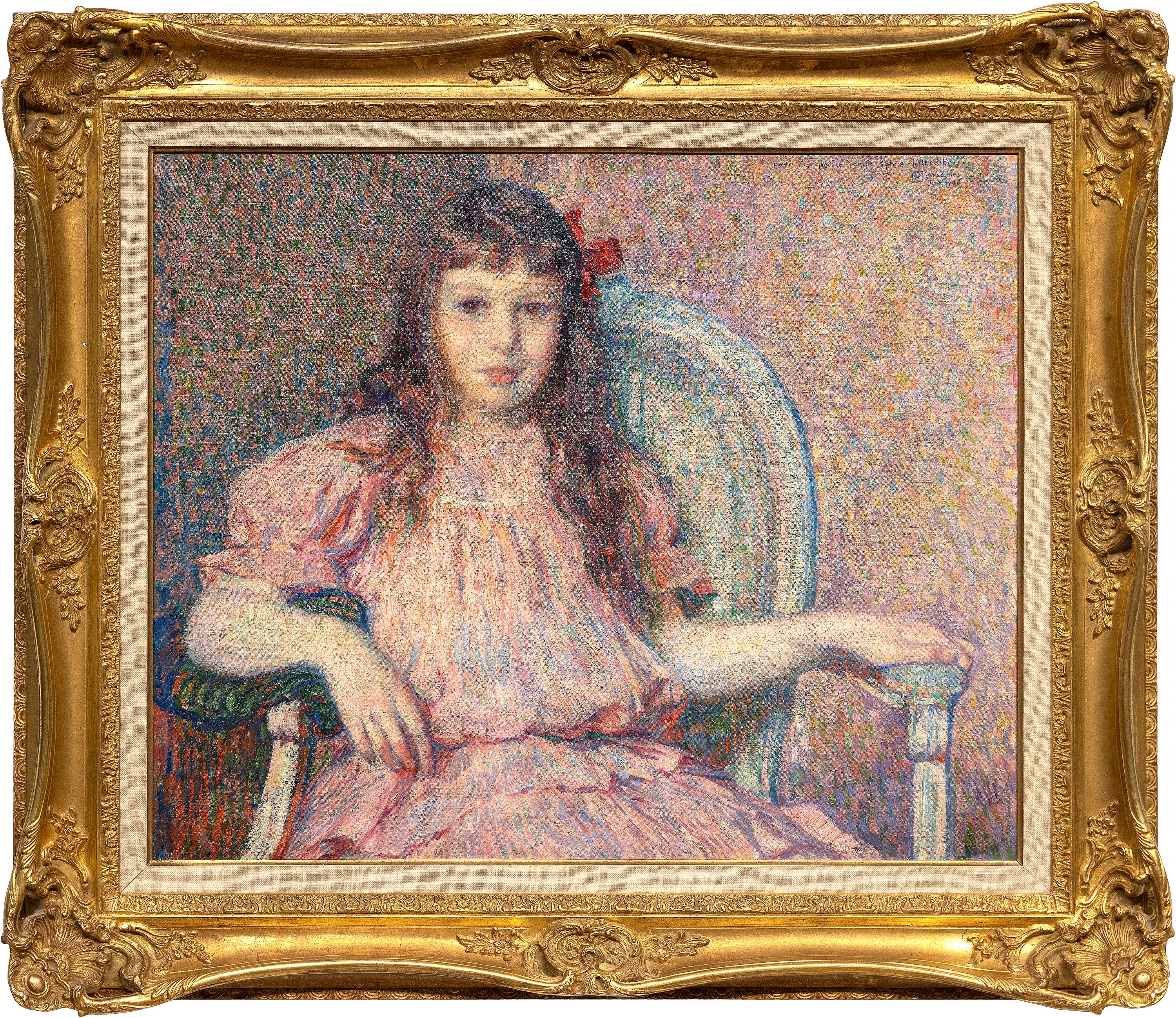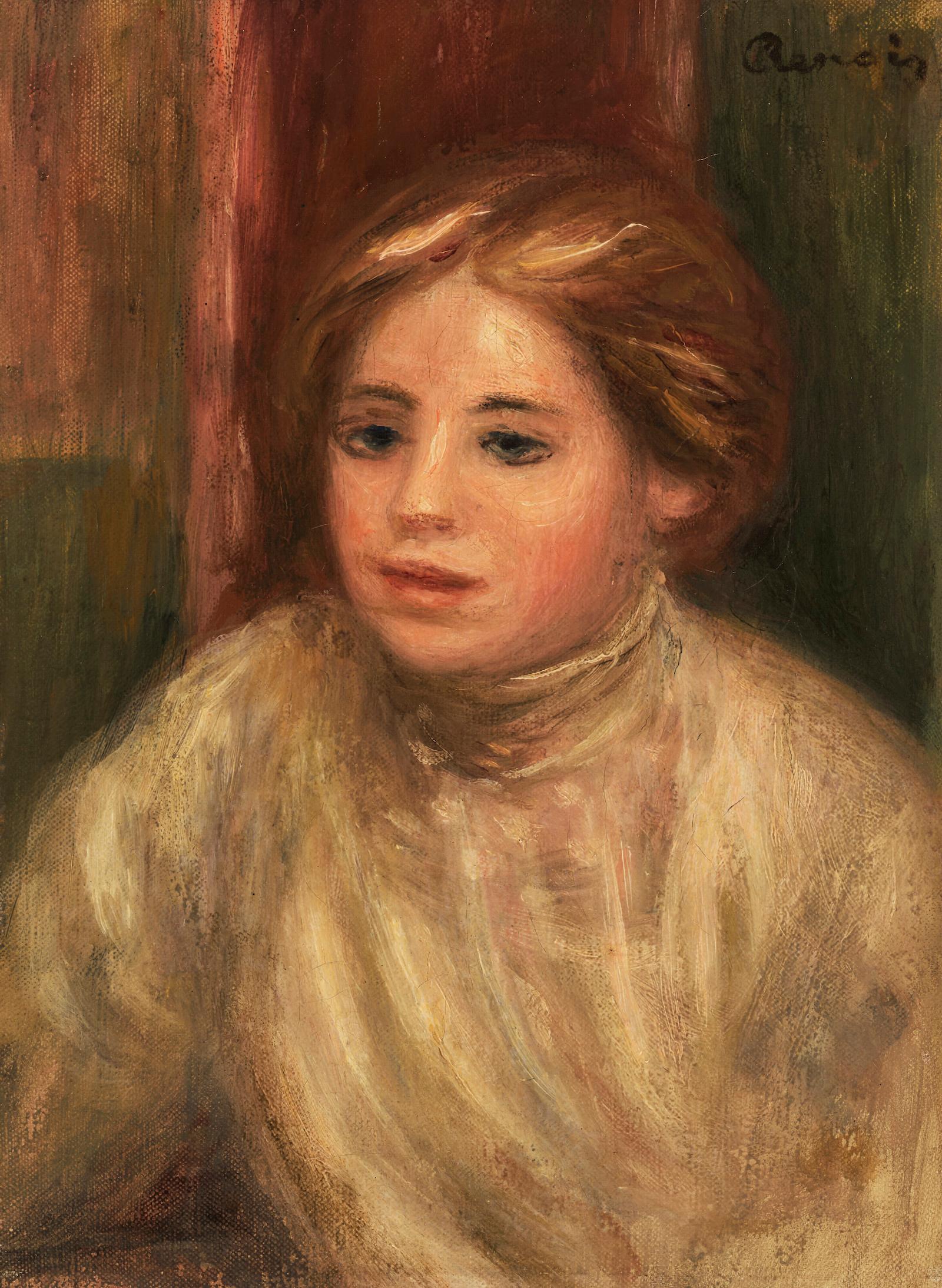Items Similar to Queen Mary Greeting School Children - British 1910 royalty portrait oil painting
Want more images or videos?
Request additional images or videos from the seller
1 of 14
Gerald Spencer PryseQueen Mary Greeting School Children - British 1910 royalty portrait oil paintingCirca 1910
Circa 1910
About the Item
This lovely British Post Impressionist oil painting is by noted artist Gerald Spencer Pryse. Painted circa 1910 the painting depicts Queen Mary greeting a large group of school children. The children and the Queen are in the foreground and buildings beyond. She is dressed in a black coat and white blouse with a neat, decorated black hat with a sliver broach on it. The brushwork on the children's dresses and hair is bold and confident and one clearly gets a sense of their excitement as they crowd forward. A lovely painting by a very talented artist and of historical and social interest.
Signed lower left.
Provenance: From the artist's estate.
Christie's stamp verso.
Condition. Oil on canvas, 20 inches by 16 inches and in good condition.
Frame. Housed in a complementary James Bourlet frame, 27 inches by 23 inches and in good condition.
Gerald Spencer Pryse (1882–1956) was a British artist and lithographer. Born at Ashton, Pryse studied in London and Paris, and first won a prize at the Venice International Exhibition in 1907. In the same year, he joined the Fabian Society, and helped to found The Neolith, a periodical of literature and the fine arts; the journal was printed in lithography. He was a regular exhibitor at the Senefelder Club, and contributed works to Punch, the Strand Magazine, and The Graphic. During the Great War, Pryse produced a considerable body of lithographic work, some of it in colour under the title Autumn Campaign (1914). This was based on his time in France and Belgium at the beginning of the war when he drove around in a Mercedes carrying lithographic stones in the back. He served as a dispatch rider for the Belgian government and was present at the Siege of Antwerp. The artist wrote a memoir of this time entitled Four Days: an account of a journey in France made between 28 and 31 August 1914, published by John Lane in 1932. Pryse also saw some of the Battle of the Marne and the Aisne but was back in Belgium to record the fall of Ostend and the subsequent retirement along the River Yser. Pryse also worked with the Indian Army in France and several of his lithographs depict scenes of Indian troops. Later, he served as a captain in the Queen Victoria's Rifles, King's Royal Rifle Corps, and was mentioned in dispatches. His main action was in the Third Battle of Ypres where he won the Military Cross, the 1914 Star, the Order of the Crown of Belgium, the Croix de Guerre. By the end of 1916, Pryse had made an application to become a war artist, and towards the end of the war, was granted permission to sketch at the front and he was able to record the conditions of trench warfare in numerous water-colour drawings, but many of these were lost in the German offensive of 1918. The remaining drawings were exhibited later in London and were described as having a freshness and authenticity that were not always apparent in the works of the official war artists. Unfortunately, many of these were destroyed by enemy action during the Second World War. He left the regiment at the end of the war but rejoined it in 1921 when the battalion was stationed at Wormwood Scrubs for three months during a coal strike. During the war, he also designed a number of posters including several published by Frank Pick for the Underground Electric Railways Company of London in London, as well as for the Labour Party, The British Red Cross, and for the Empire Marketing Board. One of his most famous posters, entitled The Only Road for an Englishman, shows a regiment of British soldiers marching through a ruined town. Pryse was one of the illustrators selected by Percy Bradshaw for inclusion in his The Art of the Illustrator (1917–1918). He worked in Hammersmith from 1914 to 1925, but in 1925 travelled to Morocco and observed some of the fighting there against the French. He returned to the country and lived there for some years after 1950. Pryse was commissioned in 1924 to create a series of lithographs for the British Empire Exhibition illustrating the extent and variety of life within the British Empire. His work was part of the art competitions at the 1928 Summer Olympics and the 1932 Summer Olympics. In 1932 he married Muriel Anstace Theodora, daughter of the Rev. Laurence Farrall, and they had three daughters, one of whom, Tessa Spencer Pryse, later a landscape artist, became an art student against her father's wishes. He died at Cranford House, Stourton, Worcestershire on 28 November 1956 aged 74.
- Creator:Gerald Spencer Pryse (1882 - 1956, Welsh)
- Creation Year:Circa 1910
- Dimensions:Height: 23 in (58.42 cm)Width: 27 in (68.58 cm)Depth: 2 in (5.08 cm)
- Medium:
- Movement & Style:
- Period:
- Condition:
- Gallery Location:London, GB
- Reference Number:1stDibs: LU853113342482
About the Seller
5.0
Platinum Seller
These expertly vetted sellers are 1stDibs' most experienced sellers and are rated highest by our customers.
1stDibs seller since 2018
402 sales on 1stDibs
Typical response time: 1 hour
- ShippingRetrieving quote...Ships From: London, United Kingdom
- Return PolicyA return for this item may be initiated within 14 days of delivery.
More From This SellerView All
- Portrait of Water Bearers, Africa - British 1920's Orientalist art oil paintingBy Gerald Spencer PryseLocated in London, GBThis superb vibrant Orientalist Post Impressionist oil painting is by noted British artist Gerald Spencer Pryse. It was painted about 1925 when Pryse was visiting Morocco and Norther...Category
1920s Post-Impressionist Portrait Paintings
MaterialsOil
- Family Portrait in Market - British 1914 art Post Impressionist oil paintingLocated in London, GBThis charming early twentieth century Post Impressionist portrait oil painting is by British Jewish female artist Amy Julia Drucker. Of German descent, Drucker was born in England i...Category
1910s Post-Impressionist Portrait Paintings
MaterialsOil
- Tangiers Lemon Market - British 1920's Oriental Figural art oil paintingBy Gerald Spencer PryseLocated in London, GBThis superb vibrant Oriental Post Impressionist oil painting is by noted British artist Gerald Spencer Pryse. It was painted circa 1925 when Pryse first visited Morocco. He was so en...Category
1920s Post-Impressionist Figurative Paintings
MaterialsOil
- Onward Christian Soldiers - British Edwardian 1911 art religious oil paintingBy Frank Owen SalisburyLocated in London, GBThis striking British Edwardian religious oil painting is by noted artist Francis 'Frank' Owen Salisbury or Frank O'Salisbury as he is largely known. Painted in 1911 it is a figurative landscape of soldiers on the battlefield. The two central characters, the 'Christian Soldiers' from the early crusades have halos and ride through the chaos on white horses. Shafts on light with angels illuminate them and also a crucifix. A very powerful Edwardian religious oil painting and an excellent example of O'Salisbury's work. painted in oil and illuminated in gold leaf. Signed and dated with monogram lower right 1911. Provenance. From Castle of Park, Aberdeenshire. A version of this painting was exhibited at the Royal Academy London in 1911 entitled the Passing of War. Condition. Oil on canvas, 36 inches by 24 inches unframed and in good condition. Frame. Housed a complementary frame, 44 inches by 32 inches framed and in good condition. Francis ("Frank") Owen Salisbury (18 December 1874 – 31 August 1962) was an English artist who specialised in portraits, large canvases of historical and ceremonial events, stained glass and book illustration. In his heyday he made a fortune on both sides of the Atlantic and was known as "Britain’s Painter Laureate". His art was steadfastly conservative and he was a vitriolic critic of Modern Art – particularly of his contemporaries Picasso, Chagall and Mondrian. His father, Henry Salisbury, described himself as a "plumber, decorator and ironmonger" (his mother was Susan Hawes), yet his son Frank would become one of the greatest society artists of his generation. One of 11 children, Salisbury was such a delicate child that he was educated at home, in the main by his student teacher sister, Emilie. He had only a few weeks formal schooling and began work by repairing bicycles at his father’s Cycle Depot in Harpenden. Uncertain as to his ability to find and maintain a job, the family determined that he be apprenticed, at the age of 15, to Henry James Salisbury, his eldest brother, who managed a major stained glass company in Alma Road, St Albans. He rapidly acquired all the practical skills of a stained glass artist and exhibited exceptional skills in the painterly detail that was applied to glass before its final firing. This led to his brother sponsoring him to attend Heatherley’s School of Art three days a week to further a career in painting. He then won a scholarship to the Royal Academy Schools which he attended for five years and where he won two silver medals and two scholarships, including the Landseer scholarship which funded his to travel to Italy in 1896. In due course he would have seventy exhibits accepted for the annual Royal Academy Summer Exhibitions, from 1899 until 1943, though he was never offered membership, which reportedly disappointed him very much. In 1901 he married Alice Maude (d. 1951), daughter of C. Colmer Greenwood, with whom he had several children, including twin daughters Monica and Sylvia. His first Royal Academy exhibit was a portrait of Alice and he often painted pictures of their children. It is for portraiture that he is best known. His speed in producing portraits stemmed from his painting his own twin daughters every morning for an hour and his career began with child portraiture and his painting the Hertfordshire gentry and members of the Harpenden Methodist Church. He had a studio at his home, Sarum Chase. A providential meeting with Lord Wakefield, founder of Castrol Oils and a Methodist philanthropist, saw his introduction to society portraiture. Salisbury’s being selected to paint the Boy Cornwell in the Battle of Jutland then brought him to the notice of Royalty. Lord Wakefield then arranged for him to paint President Woodrow Wilson whilst he was in London, but Wilson departed for Paris and the opportunity was lost. It was to be John W. Davis, American Ambassador to London, who encouraged Salisbury to go to the USA; Davis had met Salisbury at art receptions and had admired his child portraits. Twenty-five members of the Royal House of Windsor sat for Salisbury and he was the first artist to paint HM Queen Elizabeth II. In 1919 he painted a mural for the Royal Exchange, London National Peace Thanksgiving Service on the steps of St Paul’s Cathedral, 6th July 1919. He painted Winston Churchill on more occasions than any other artist; the two iconic images of Churchill – The Siren Suit and Blood, Sweat and Tears are both Salisbury images. Mayoral regalia was a ready made requisite for the Salisbury style with Councillor Sam Ryder (of Ryder Cup fame) as Mayor of St Albans being the most famous of his civic images. Other significant portraits include those of Richard Burton, Andrew Carnegie (posthumous), Sir Alan Cobham, Sir Robert Ludwig Mond, Maria Montessori...Category
1910s Realist Figurative Paintings
MaterialsOil
- Madonna and Child with St Catherine and Putti - Italian 17thC art oil paintingBy Giuseppe Bartolomeo ChiariLocated in London, GBThis stunning Italian 17th century Old Master religious oil painting is by Baroque artist Giuseppe Bartolomeo Chari. Painted circa 1684 it is a large and vibrant oil painting of the Madonna and child. To their left is Saint Catherine and to their right four putti or cherubs look upon a sleeping Jesus. The detail in all the figures faces and hair and the colouring is just superb, especially the Madonna's sumptuous blue robe. A really fabulous 17th century religious work with previous full attribution and excellent provenance which was once attributed to Carlo Maratta (1625-1713). Provenance. With Vangelisti, Lucca, Italy, 1966, from whom acquired by the family of the previous owner, and thence by descent. Red seal stamp verso Christies April 15th 1912 Christies March 23 1956 Condition. Oil on Canvas. Image size 44 x 54 inches unframed and in good condition. Frame. Housed in an original Carlo Maratta frame, 62 inches by 52 inches framed and in good condition. Giuseppe Bartolomeo Chiari (1654-1727), also known simply as Giuseppe Chiari, was an Italian painter of the late-Baroque period, active mostly in Rome. Born in Rome, he was one of the main assistants, along with Giuseppe Passeri and Andrea Procaccini, in the studio of an elder Carlo Maratta. His father had opposed the career, but his mother, on the recommendation of a painter named Carlo Antonio Gagliani. By the age of 22, he had frescoed the lateral lunettes (Birth of Virgin and Adoration of Magi...Category
17th Century Old Masters Portrait Paintings
MaterialsOil
- The Gossip - Scottish 19thC art Victorian oil painting young romantic coupleBy William Fettes DouglasLocated in London, GBA fine Victorian Scottish genre oil on canvas painting which dates to 1868 and is titled The Gossip by famous Scottish artist William Fettes Douglas RSA. It is a stunning depiction o...Category
19th Century Victorian Figurative Paintings
MaterialsOil
You May Also Like
- Portrait of a Girl in Nature - Mid 20th Century Oil by Michael D'AguilarBy Michael D'AguilarLocated in Watford, HertfordshireBaron Michael D`Aguilar was born on May 15, 1922 in London to Spanish parents. He was brother of the artist Paul D`Aguilar. He spent much of his early life in Spain. He studied at...Category
1940s Post-Impressionist Figurative Paintings
MaterialsOil
- Mid Century Fauvist Portrait of Red Headed WomanBy Sydney HelfmanLocated in Soquel, CAStriking Fauvist portrait with a vibrant, high voltage color palette, featuring a green woman with red hair by Sydney Helfman (American, 1926-2010). Aut...Category
1960s Fauvist Figurative Paintings
MaterialsLinen, Oil
- 'Young Girl Seated', Paris, Louvre, Salon d'Automne, Ac. Chaumière, LACMA, SFAABy Victor Di GesuLocated in Santa Cruz, CASigned lower right, 'Di Gesu' for Victor Di Gesu (American, 1914-1988) and dated 1971; additionally signed, verso, and titled, 'Leslie'. Winner of the Prix Othon Friesz, Victor di G...Category
1970s Post-Impressionist Figurative Paintings
MaterialsOil, Illustration Board
- Maria Van Rysselberghe au coin du feuBy Theo van RysselbergheLocated in Palm Desert, CA"Maria Van Rysselberghe au coin du feu" is a portrait painting by Post-Impressionist Théo van Rysselberghe. The portrait is signed lower right, "Atelier Van Rysselberghe". The framed...Category
1910s Post-Impressionist Portrait Paintings
MaterialsCanvas, Oil
- Portrait de Sylvie LacombeBy Theo van RysselbergheLocated in Palm Desert, CA"Portrait de Sylvie Lacombe" is a Post-Impressionist painting by Théo van Rysselberghe. The portrait is signed with monogram and dedication, upper right, "pour ma petite amie Sylvie ...Category
Early 1900s Post-Impressionist Portrait Paintings
MaterialsCanvas, Oil
- Tête de Femme Blonde by Pierre-Auguste Renoir - Portrait paintingBy Pierre-Auguste RenoirLocated in London, GB*PLEASE NOTE UK BUYERS WILL ONLY PAY 5% VAT ON THIS PURCHASE. Tête de Femme Blonde by Pierre-Auguste Renoir (1841-1919) Oil on canvas 26.1 x 19 cm (10 ¹/₄ x 7 ¹/₂ inches) Signed upp...Category
Early 1900s Post-Impressionist Portrait Paintings
MaterialsCanvas, Oil
Recently Viewed
View AllMore Ways To Browse
Graphic Portrait
German Art Of Children
1919 Portrait
Military Portrait
Antique Oil Painting Red
French Military Paintings
British Empire
French Royalty
John Queen
Large Painting Party
Antique Military Painting
Mary King
Antique Battle Painting
Soldier And War Painting
Large Military Painting
Queen Mary
Queen Crowns
French Empire Paintings





